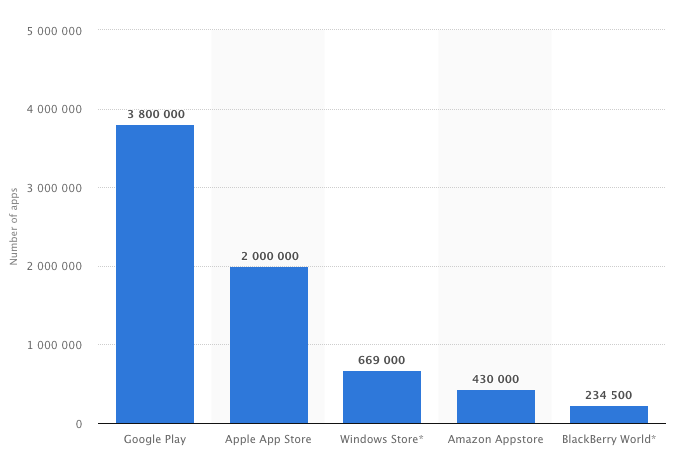Running a startup can be one of the most fulfilling things you’ll ever do in your career, even if you run it straight into the ground. Still, I think we can all agree it’s best not to.
If you’re determined to develop an app (either as a core product or as a growth accelerator), you’ll need a strategy. Otherwise, you run the risk of developing a hot mess.
There are over seven million available apps across the top 5 app stores. So, you don’t get any originality points just by developing an app.

Source: Statista
In such a crowded market, your only chance to get a piece of the pie is actually developing a quality product that people will want to use.
The thing is, quality will only get you a foot in the door. Revolutionary apps are built on revolutionary ideas. It’s best if you decide right now if that's what you’re striving for.
Breaking the mold in the mobile app world means adopting a strategy that lets you go off script from time to time when you run into unexpected problems. Not 'if', but 'when'.
Mobile app development strategies aren’t set in stone. Companies tailor their game plan to their specific needs so we can’t give you a simple A, then B, then C solution.
What we can do is make you ask the right questions, which will lead you to your own conclusions:
1. Do you need an app?
When it comes to mobile app development strategies, the first step is actually one of the easier ones: decide if you actually need an app.

Ask yourself “Can I achieve my goal without building a mobile app?”
If the answer is yes, then you have at least two options, maybe more. Since you’re running a business, a startup no less, choose the path of least resistance.
If your only goal is to interact with people on mobile devices, for example, a mobile-friendly website can do the job just fine.
Apps are the better choice when:
- You want to let your audience perform more complex actions.
- You want to add functionalities that would bloat the website and slow down the load time.
- You want to encourage repeat interactions between the users and your brand.
- You want your company to be a click away, even if there is no internet connection.
- You want to boost your marketing results through in-app and push notifications.
- You want to enhance user experience by using the mobile device’s features.
The aforementioned features require work and time, though. If you’re not completely committed to app development, you’re better off stopping right now. It’s not that half-assing it won’t get results, it’s just that they’re going to be half-ass results.
Think long and hard before making a decision. You don’t want to shoot yourself in the foot just as your startup is getting off the ground.
2. Web, Native or cross-platform?
Not all apps are created equal. I don’t mean that in a derogatory way, it’s just that different architectures lead to different apps. The first part of defining that architecture is choosing between these three options.
We’re going to focus more on the business side here. You should definitely read this article about the mobile app development process if you want more technical details.
Web Apps
If you’re bouncing between mobile app development and responsive web design, you might want to take the middle road. Web apps load in the browser, they’re basically the pinnacle of mobile-optimized websites (or at least they should be).
Advantages:
- It’s the simplest, fastest and least expensive app to build.
- It works on all devices and operating systems.
- People can use it right away, no download required.
- Since it’s on the web, updates apply instantaneously to all users.
Disadvantages:
- As the web app is basically a part of your website, the site itself also has to be up to snuff, both from a technical standpoint and design-wise.
- It won’t work without an internet connection.
- Its functionalities are limited compared to other types of apps.
- As it’s not installed on users’ devices it’s less likely to get return visits.
The main programming languages used in web apps are HTML and CSS. Depending on what you need, that can either be a good thing or a bad thing.
Native
While ten years ago, the mobile OS landscape resembled the wild west, with tens of different competing systems, today’s market is quite simple. There is Android and there is iOS. Together, they own over 95% of the mobile OS market share. The problem is their apps are platform-specific.
Native apps imply the largest investments.
This kind of app is the fastest and most reliable. Seeing as we are talking about mobile app development strategies for startups, building a native app is a "putting all your eggs in the same basket" type of deal, considering the large undertaking.
If the app is going to be a core product and you plan on adding a lot of functionalities to it, native is your best bet. Remember though, just because an app is native doesn’t mean it’s going to be any good. If anything, it’s the hardest to develop and the most prone to encounter problems.
The main difficulty comes from the fact that you’ll need to build the same app twice: one for Android and one for iOS. Even if they’ll have the same logic and functionalities, you’ll be using different codebases.
You’ll need developers that know Java or Kotlin for Android and Swift or Obj-C for iOS, plus the software development kits for each.
Using different teams for the two app versions will cut on time requirements but we advise against it. If the two teams don’t communicate perfectly, you run the risk of ending up with two different apps. Hiring a single team is safer, but you really need to screen the developers first since they need to be well-versed in several programming languages and SDKs.
Cross-platform
Maybe the most cost-effective type of mobile app, a cross-platform application is a compromise between functionality and budgeting.

The idea behind cross-platform apps is to use programming languages that are neither specific to Android nor to iOS (usually Javascript and HTML) in order to build a single version of your mobile app. Then, with the right framework, you can deploy it to both platforms as is, for the most part.
It’s not a perfect solution, as cross-platform apps tend to struggle to keep up with the more specialized native ones. Still, the workload is basically cut in half if you decide to go cross-platform since you write the code once.
The most popular framework for this right now is React Native, which we’re having a blast with. Another good option in our opinion is NativeScript.
3. How is the app going to help you?
First of all, let’s split apps into two categories:
Primary apps are the product itself. Examples here are plenty. Most mobile games are primary apps. You get it on your phone and you play it. That’s the product, that’s the whole experience.
Complementary apps are meant to enrich customer experience for another product. An example is our own startup, Cleverwash. The real service Cleverwash provides is the fact that it sets up a car wash appointment for you. That’s done on a remote server. The Clevewash app is just a better way for people to make appointments on the go but they could still do it on a desktop.
Complementary apps don’t have to bring revenue on their own but they still could. It’s up to you if you’ll use it as an additional source of revenue or keep it true to its original purpose.
A mobile app can act as a solution to many 'business opportunities'. These are just a few of them:
Increasing customer satisfaction
Usually, this is what businesses try to achieve through the use of complementary mobile apps. That isn’t to say it has no monetary uses. In Clevewash’s case, we saw a much larger conversion rate on the app that on any other platform.
Making the user experience better can be difficult. You’ll need talented designers and plenty of time for development and testing to make a real difference.

If you want to be more hands-on in the design process (and you should), you can check out the design guidelines for Android and iOS. Knowing what you’re working with will be a huge help in defining your vision for the finished product.
Better branding
A common hurdle startups encounter while trying to flesh out their brand is lack of customer interest. While your business idea may be revolutionary, you’re hardly the first to present it as such.
The sad truth is people won’t be interested in your brand until you capture their interests with your products. Here’s where mobile apps come into play.
If you successfully convince users to install your app, that means you’ve got them interested. Once your app logo is planted into their phone, it can act as a connection between you.
The thought process behind this is simple: the user already made a commitment by installing the app. Then, they’ll want to learn more about it and the developing company because:
- They want to know if the investment was worth it.
- They want to get as much us out of the app as possible.
- They want to get more useful products / services from the developer.
Whatever their motivation, the result is the same. Your app users are receptive to your branding messages. You’ve got the chance to turn curious shoppers into loyal customers.
Add some material about your company culture, mission, maybe even an about the team section. Social media buttons will also work nicely as long as you don't shove them down users' throats.
Finding new audiences
On the app store, two kinds of people are going to run into your app: those who actively search for your services and those who are just in the habit of browsing the app store. While the first will seek you out, connecting with the second group is an opportunity you can't pass up.
As an entrepreneur, you’ve probably heard of search engine optimization. If not, start studying. When budgets are tight, free organic leads are a godsend.
Anyway, a less encountered term is app store optimization, which is basically SEO for app stores.
Don’t panic, the rules and best practices are basically the same. The idea here is that developing an app gives you the chance to start gaining leads and customers from a brand new pool: app store shoppers.
That sweet, sweet money
A strong brand and tons of leads are great, but at the end of the day, they won’t keep the lights on in the office. So how can mobile apps bring in revenue?
In plenty of ways, actually. Here are a few common methods:
Monthly subscriptions
While the basic principle of paid subscriptions is easy to understand, there are many nuances to it. For example, you could implement several payment tiers, the higher ones offering more functionalities for a larger fee.
Don’t get too greedy, though. Plenty of awesome apps are free to use and the consumers know it. You'll have to really offer something special.
Furthermore, plenty of apps adopt the freemium strategy: the app itself is free to use but you offer a more advanced option for a fee. It’s an excellent way of gaining the users’ trust. This way, they can test the app first and know if they truly want the premium version.
One-time only purchases
If you don’t expect the mobile app to get plenty of updates or new functionalities after launch, it can be hard to justify a monthly subscription. In this case, playing once for the app and having it forever is a better option.
While this can somewhat limit future developments, it’s a straightforward way of regaining your investment and making a profit. Also, you can focus on the next project.
In-app purchases
Besides other billing methods, you could also include in-app purchases or microtransactions. Basically, you’re turning your mobile app into a virtual market, where users can buy small advantages or features for the app.
The practice is most widespread among mobile games, but it’s not limited to that medium.
A word of warning: microtransactions work best in free apps. No one likes paying for a mobile app only to be asked for more money. It feels cheap.
Advertising
While not always applicable, apps can also get revenues by hosting ads in-app. While a valid option, I suggest you steer away from it unless you’re developing a game or some type of news aggregator.
Ads are annoying and they’ll diminish user satisfaction. Stay away from them if you’re developing a complementary app!
Who should handle mobile app development?
In case you don't have that much hiring experience as a startup, Toptal has a fantastic hiring guide you can save as a reference.

Let’s start with the most straightforward point:
Programming skills
Depending on the app type, you’ll need different programming languages. The most reliable way to make sure that the devs know their stuff is to take a look at their previous work. Download the apps they built and take them for a spin.
Buying a 3-dollar app you don’t need and finding out it’s subpar can save you thousands down the line.
Another good tell is their Github account. You can tell a lot about a person or even a company by taking a look at the code they post online. Look for passionate people who see programming as more than just a way to make money.
If you've got the time (and possibly money), you can ask for a demo app with a part of the functionalities you want. This is the most surefire way of seeing them in action.
Lastly, don’t give up on a promising team just because they don’t use the native programming languages for a specific platform. As previously mentioned, you can develop for both iOS and Android using Javascript and that’s not your only option. C#, for example, can also be used on both platforms with a bit of tweaking.
References
Knowledge and experience do not equal work ethic. Once you know that a team is able to do the job, new questions are going to come up:
- Are they meticulous?
- Are they communicative?
- Are they honest with their clients?
- Are they open to feedback and ready to contribute with their own ideas beyond just app development?
Come up with as many questions like these as you can and start asking. Who knows, a seemingly unimportant question might save you a lot of hardship.
I recommend you look for the devs up on Clutch, you might find useful reviews there. Another thing you should do is check them up on Crunchbase, which offers some general information about their company.
Still, we suggest you get in touch with a few of their previous clients and ask them about the team. If the devs really are great, previous clients will be happy to tell you about them. Same goes if they’re actually terrible.
Team Size
When balancing both a budget and a timeframe, one of the biggest factors in tipping the scale is the number of developers you’re recruiting.
A big team will mean that your app will be done quicker. Naturally, it also means that the costs are going to rise, too. Our advice is to set a priority. Either money is more important or time is. Set a limit on the more important one and then see how it’s going to take a toll on the other. From there, you can always make adjustments.
The point is to create a clear hierarchical structure of priorities that you can use as a reference for just about any decision.
Approach your potential collaborators with a clear statement: “you’ll have this budget” or “you’ve got this amount of time to finish the app”. They’ll best know how to allocate manpower based on that.

5. How are you going to market your app?
Even if you create a real gem of an app, remember that it’s going to join seven million more on the market.
The sad truth is that without any marketing, it’s unlikely that your app will get the recognition it deserves. That’s why you need to add marketing to your mobile app development strategy.
First of all, you need to start making waves while the app is still in development:
- Create content centered around the app (articles, case studies, whitepapers etc.).
- Post about it on social media.
- Test other platforms for possible opportunities (Quora, Reddit, Medium etc.).
- Look into possible events or conventions where you can showcase your work.
We understand that money is tight in a startup. That’s why we’re focusing here on cheap or completely free marketing endeavors. The lessons here is that you shouldn’t give up on marketing.
The thing about mobile app marketing is that it works like a snowball. Exposure brings more exposure and if you manage to make a big splash with the launch, you can ride the wave straight to app stardom.
Running a startup can actually bring you a few unique advantages. Startup culture is going strong and plenty of conventions focus on giving you the chance to show your ideas to the world (and to possible investors).
The best advice I can give you is: think outside the box!
Try getting sponsors, give demos out to thought leaders, find a unique voice for your brand, the list goes on. In a way, a startup offers you a huge deal of freedom: nothing is set in stone, everything is possible until proven otherwise.
The five questions we discussed here are meant to keep you on track and help you avoid pitfalls. That being said, we think that original ideas make the world go round, so don’t be afraid to try new things.
If you’re not sure how to turn your app idea into a reality, drop us a line! We pride ourselves in the work we do for startups and, who knows? We might just create something beautiful together!



